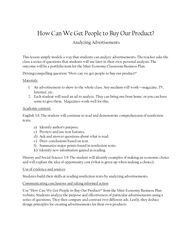
Return to flip book view
How Can We Get People to Buy Our Product? Analyzing Advertisements This lesson simply models a way that students can analyze advertisements. The teacher asks the class a series of questions that students will use later in their own personal analysis. The outcome will be a portfolio item for the Mini-Economy Classroom Business Plan. Driving/compelling question: “How can we get people to buy our product?” Materials: 1. An advertisement to show to the whole class. Any medium will work—magazine, TV, Internet, etc. 2. Each student will need an ad to analyze. They can bring one from home, or you can have some to give them. Magazines work well for this. Academic content: English 3.6: The student will continue to read and demonstrate comprehension of nonfiction texts: a) Identify author’s purpose. c) Preview and use text features. d) Ask and answer questions about what is read. e) Draw conclusions based on text. f) Summarize major points found in nonfiction texts. k) Identify new information gained in reading. History and Social Science 3.9: The student will identify examples of making an economic choice and will explain the idea of opportunity cost (what is given up when making a choice). Use of evidence and sources Students build their skills at reading nonfiction texts by analyzing advertisements. Communicating conclusions and taking informed action Use “How Can We Get People to Buy Our Product?” from the Mini-Economy Business Plan website. Students analyze the purpose and effectiveness of particular advertisements using a series of questions. They then compare and contrast two different ads. Lastly, they deduce design principles for creating advertisements for their own products.
Procedure: Since the portfolio item the students will use is almost identical to the questions you will ask, feel free to give them the activity sheet and to reference it liberally. 1. First, choose an advertisement to show the class. 2. Ask the following questions: a. What are advertisements for? b. Does this advertisement communicate information that is useful or helpful for you? Why or why not? c. How is the advertisement intended to make you feel? d. Do you think the advertisement is truthful? Explain. e. Does this advertisement actually make you want the product more? Why or why not? f. What could the producer do to make you want the product more? g. If you chose to consume this product, what would your opportunity cost be? (That is, what would you choose not to consume?) i. [Ask individual students—everyone’s opportunity cost should be a different good or service] ii. Review the concept of opportunity cost. Remind students that it is the next best thing that you gave up when you made a choice. Remind that that “an opportunity cost is an opportunity lost!” and that “choosing is refusing!” h. Based on your answers above, rate this advertisement on a scale of 1 (“not a good ad”) to 10 (“A very good ad”). Show me your rating by holding up your fingers! i. Ask students why they gave the ad the rating that they did. 3. Distribute the “How Can We Get People To Buy Our Product?” activity sheet. Students should analyze another advertisement using the sheet in groups or alone (as homework). 4. A key part of their analysis will be application: what does this ad tell us about how to market our own product? The analysis will be put in their business portfolio and graded.